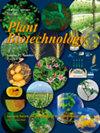Micropropagation of Solanum quitoense var. quitoense by apical bud, petiole and hypocotyl culture.
IF 1.4
4区 生物学
Q4 BIOTECHNOLOGY & APPLIED MICROBIOLOGY
引用次数: 2
Abstract
The development of in vitro propagation methods can improve the current commercial use and conservation of plants like naranjilla (Solanum quitoense), a distinctive Andean crop and key emerging agricultural product. In the present study, we report in vitro culture protocols for naranjilla apical buds, hypocotyls and petioles. In apical bud culture, MS medium supplemented with 0.10 mg l-1 1-naphtaleneacetic acid (NAA) produced longer plantlets with greater number of leaves. Hypocotyl culture yielded higher number of shoots when using older explants in MS medium supplemented with different combinations of NAA, 6-benzylaminopurine (BAP) and gibberellic acid (GA3). Petiole culture produced a significantly higher number of shoots per explant, with more abundant and bigger leaves, when using MS medium supplemented with 0.02 mg l-1 NAA, 4.50 mg l-1 BAP and 1.00 mg l-1 GA3. A factorial analysis reveals that the interaction between GA3 and NAA/BAP plays an important role in shoot regeneration. These results provide new tools for the in vitro regeneration of naranjilla plants, improving on previously reported protocols for this species by using alternative explant types and regeneration protocols.利用顶芽、叶柄和下胚轴培养进行茄属植物的微繁殖。
体外繁殖方法的发展可以改善目前植物的商业用途和保护,如naranjilla(Solanum quitoense),这是一种独特的安第斯作物和关键的新兴农产品。在本研究中,我们报道了naranjilla顶芽、下胚轴和叶柄的体外培养方案。在顶芽培养中,添加0.10的MS培养基 毫克 l-1-萘乙酸(NAA)产生的植株较长,叶片较多。在添加NAA、6-苄基氨基嘌呤(BAP)和赤霉酸(GA3)不同组合的MS培养基中使用较老的外植体时,下胚轴培养产生较高的芽数。当使用添加0.02的MS培养基时,叶柄培养基每个外植体产生的芽数显著更高,叶片更丰富、更大 毫克 l-1 NAA,4.50 毫克 l-1 BAP和1.00 毫克 l-1 GA3。因子分析表明,GA3与NAA/BAP的相互作用在芽再生中起着重要作用。这些结果为naranjilla植物的体外再生提供了新的工具,通过使用替代外植体类型和再生方案改进了先前报道的该物种的方案。
本文章由计算机程序翻译,如有差异,请以英文原文为准。
求助全文
约1分钟内获得全文
求助全文
来源期刊

Plant Biotechnology
BIOTECHNOLOGY & APPLIED MICROBIOLOGY-PLANT SCIENCES
CiteScore
2.90
自引率
18.80%
发文量
45
审稿时长
6-12 weeks
期刊介绍:
Plant Biotechnology is an international, open-access, and online journal, published every three months by the Japanese Society for Plant Biotechnology. The journal, first published in 1984 as the predecessor journal, “Plant Tissue Culture Letters” and became its present form in 1997 when the society name was renamed to Japanese Society for Plant Cell and Molecular Biology, publishes findings in the areas from basic- to application research of plant biotechnology. The aim of Plant Biotechnology is to publish original and high-impact papers, in the most rapid turnaround time for reviewing, on the plant biotechnology including tissue culture, production of specialized metabolites, transgenic technology, and genome editing technology, and also on the related research fields including molecular biology, cell biology, genetics, plant breeding, plant physiology and biochemistry, metabolic engineering, synthetic biology, and bioinformatics.
 求助内容:
求助内容: 应助结果提醒方式:
应助结果提醒方式:


